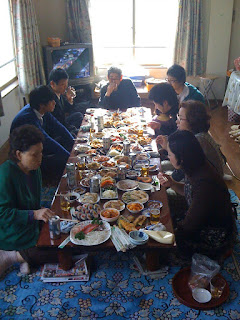Japan is internationally recognized as an incredibly generous society that gives and gives, gifts and gifts. It is also recognized as a society of secrets and darkness. ("In Praise of Shadows", yuugen, wabi-sabi, and I remember Leigh enjoying how incredibly dark and mysterious the inside of temples, shrines, and sacred places are over here.) Remember, ninjas and seppuku.

“Keeping it secret keeps it sacred. And aren’t those two words related?”
-My Boss
On new years, we in the west make resolutions....in Japan, they buy themselves and their friends charms--beautifully folded and wrapped secret papers that live inside tiny, colorful cloth pouches; charms for a healthy child-birth, academic success, loving relationships, safe travels, or my favorite: charms for good luck driving that suction-cup to the windows. These charms (o-mamori) are very sacred and cannot be opened under any circumstances. What’s inside is a total secret: nobody knows.
My friend Yuuki gave me a beautiful yellow one with the kanji for “gold” (金) embroidered into it.
“Where should I put it?” I asked.
‘Traditionally? Omamori for money go in your wallet.”
So, a magic Japanese voodoo attraction charm is in my wallet right now. It’s a bit bulky, but totally traditional, and maybe, just maybe.... I think superstations are signs of a residual magic and mythic mind. There is nothing wrong with them. They point to our past, and how we used to see the world.
Here is one of my students who keeps his omamori in his jacket pocket. I've heard that some people actually sew the charms into their clothing.

And here they are dangling from the kid's backpacks. I think there are 7 in this picture.
At the end of the year, everyone must bring all their charms to the shrine to be ritually burned (and of course everyone must buy new charms from the shrine for the next year.) And these little cloth pouches are five~ten dollars each! Even so, the old charms (and daruma buddhas, portable shrines, arrows, wreaths, etc ) must be burned, or they become cursed with bad luck.
(Sounds to me like a wasteful, money-making scam that maybe, just maybe has roots in a meaningful spiritual practice of detachment and purification, and maybe has the potential to inspire transformation, but...you should see the piles and piles of brand new wreaths and shrines burned every year...it’s amazing.) I asked my students why we must burn the charms and one said, “because after a year their power is all used up...”
To me, these tiny charms represent so much of what it means to be in Japan. Putting aside the wasteful, thoughtless, ritualistic overconsumption, there is an extremely poetic, powerful symbol there: a secret depth and magic enfolded in layer upon layer of radiant cultural wrappings.
Paper Charms spilling into other religions: the Tenseishinbikai church, with whom I ate dinner with just last night, claim to get their miraculous healing hand-power from the paper-charm they wear around their necks. I asked one member what was inside, and he didn't consider it so much of a secret (This church tries to distance themselves from pre-rational Shinto folklore.) Inside the pouch is a tiny folded up piece of paper with the character for LIGHT “光” written in the handwriting of their religion’s founder. If you wear it, you get the power.
Returning to the idea of keeping things secret, the hibutsu of Japan are the most fascinating of all. This is the tradition of keeping sculptures of the Buddha hidden in cabinet-shrines called zushi that are only opened once every seven, thirty-three, or sixty years! Sometimes they are never opened, and the art inside stays secret forever! And that somehow helps the devotee transcend their body-mind and find their Absolute Identity with the One Love? Maybe. But I like how it makes the art inside increase in power. Just imagine if Michelangelo’s David was only revealed to the public once every sixty years! Like a total eclipse, the art would become a once-in-a-lifetime experience...
So we were at the big sacred tree, inside the meditation room, and sure enough, right in the center of the alter where the main image (honzo) would be, there was a dark, dusty, exquisitely carved, closed zushi cabinet hiding the hibutsu.
“Do you want to open it?” Oga asked. Hah! I was shocked! We could have totally opened the miniature shrine too, but would have had to first move the circular mirror blocking the door. The mirror acted almost like a “Keep Out!” sign, and it said: “Here! Just look at yourself! There is where the real “secret buddha” resides anyway.”
So we didn't open it. Instead we lit incense, meditated, and made music.








